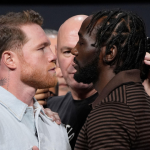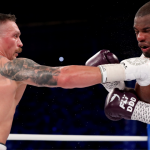IN December, Josh Warrington met the universally beloved Carl Frampton and put in a career defining performance. From the opening round Warrington surged in on Frampton and spent the remainder of the fight tearing into the former WBA champ with relentless offence. The bout was an instant classic and it showed exactly why Warrington is such a difficult man to handle: solid enough punches but rapidly delivered and in tremendous volume, all without breaks or slowing down.
Warrington makes his money in the trenches; he is an infighter at heart. The downside of infighting is that it can be stifled with a clinch and then—once the referee has separated the infighter and his opponent—the combatants are on the outside playing the distance game again. To succeed as an infighter in the modern game, a boxer must be able to forestall the clinch.
He does this by posting on the opponent with his head to maintain a space between his chest and his opponent’s, or by projecting his lead shoulder in so that the opponent is attempting to hold him almost side on, with plenty of space to still put some force into his blows. Watch the Frampton fight and you will notice that Warrington leans primarily on the former method: the top of his head is posted against Frampton for the majority of the fight and his elbows are tight to his body when he isn’t crackling off combinations. This also means that Warrington ends up clashing heads with his opponent a great deal in his fights.
Warrington 33/10 Draw 20/1 Kid Galahad 47/20
We said “forestalling” the clinch and not denying it outright because just as you can’t become a boxer and expect not to get punched, you can’t be an infighter and expect to put off the clinch forever. This means that the fighter has to push his advantages on the inside, make it difficult for the opponent to tie him up, and then be able to get in from the outside once again when the opponent does grab a hold and force a referee’s break.
Warrington’s outfighting game isn’t always the prettiest—his guard is often clamped to his head—but the moment his opponent leads, Warrington will slip, come in with a counter, and immediately push into the infight once again.
Warrington’s relentless and headbutt filled performance against Lee Selby.
There are touches of science there—he will angle off to his left and fire a right hook through the front of his opponent’s guard, or pull down his opponent’s head to get a reaction and score a body shot—but he is also more than happy to just hammer away with alternate hands if the opponent cannot do something to slow him down.
A pull down into a body shot against Frampton, technically illegal but part of the infight.
Warrington’s next opponent is a mandatory challenger for his IBF featherweight crown named Abdul Bari Awad, though he is more commonly known as Kid Galahad. Kid Galahad might seem like a strange nickname but that is par for the course for a fighter who learned his craft at Brendan Ingle’s legendary Wincobank gym.
Like any Ingle fighter, Galahad is a switch hitter: he works from both a southpaw stance and an orthodox stance depending on how the mood strikes him. In fact the late Brendan Ingle used to boast that he trained his fighters out of five stances—southpaw and orthodox, but also bladed and more square from both of those stances, and finally fighting with the feet completely level. Ingle recommended you watch Naseem Hamed’s fight with Steve Cunningham to see all five in action.
But switch hitters from any gym tend to fall into habits on each of their stances. Galahad’s habits are somewhat reminiscent of the great Marvin Hagler (though obviously he is not proven to be half the fighter of Hagler at this point). Hagler would box southpaw from the outside for the most part, and then drop into an orthodox stance in close because the same stance tends to allow a fighter to get in closer and drop into traditional the traditional inside positions that we discussed Warrington using.
A fairly good example of a Galahad switch hitting performance.
Galahad’s level of competition, especially since returning from his drug suspension, has not always been great but he still moves well and picks his spots wonderfully through the rounds. He’ll snap in fast left straights from a southpaw stance out in the open, and work his man over from an orthodox stance on the inside. While his inside work is decent, that has typically been Warrington’s wheelhouse and the champ certainly works a far more threatening pace from inside positions.
Ultimately this one seems like it will come down to whether Galahad can use that Wincobank footwork to keep Warrington out of the kitchen, skewering him with the left straight and perhaps showing him with uppercuts when he threatens to close. Crucially Galahad will need to be able to tie up to stall out Warrington’s murderous infight when Warrington does get inside.
Fury vs Schwarz
The other notable boxing match taking place this weekend is Tyson Fury’s return to the ring against Tom Schwarz. In terms of tickets and ratings it might as well be a Tyson Fury open workout because Schwarz carries no name power and this is another of Fury’s very clearly advertised tune ups. Boxrec has Schwarz as their 56th best heavyweight in the world, but with Andy Ruiz’s recent victory over Anthony Joshua some fans will probably be excited for the possibility of an upset.
The difference, of course, is that Andy Ruiz was provably very good. Even if you ignored Ruiz’s lengthy and almost faultless amateur and pro careers, as we discussed in our pre-fight analysis: Ruiz can actually box. Ruiz has a lot of looks, drives an incredible pace, understands the clinch and scores great punches from there against opponents who don’t, and had looked great against the very highly regarded Joseph Parker. Andy Ruiz was ignored because he wasn’t Deontay Wilder or Tyson Fury and because he was a little chubby, Tom Schwarz is being somewhat justifiably doubted because he hasn’t actually shown much yet.
Looking at Schwarz’s work in the ring, he is a decent heavyweight. He tries to establish a jab, throws the one-two, then starts throwing the right hand to the body in hopes of setting up his right hand upstairs. He doesn’t really understand how to tie up properly—which might bite him in the arse when he gets in with an opponent who can hurt him—but he will push and jostle his man around enough that you won’t forget you’re watching a low level heavyweight bout.
Schwarz stands six-foot-five, which is nothing to sniff at, but Fury is six-foot-nine with a reach to match and at this size he is unique because he can actually box. The main difference appears to be in the footwork—Fury is a marvellous ring general who can move very well for a big man, while in the footage that is available of Schwarz he is mostly in with opponents who seem obliged to stand in front of him and engage, covering up when he throws. Barring a surprise connection early in the fight it is seems quite likely that Schwarz will show all of his tricks and get discouraged chasing after Fury.
Fury feinting, drawing, getting down behind his lead shoulder, clinching, turning his man onto shots. This is considerably slicker scientific boxing than Schwarz is used to.
Perhaps Schwarz can pull the upset, he can hit decently and isn’t a bad boxer for a heavyweight, but understand that it would be a much more significant upset than Ruiz over Joshua. But then who knows, maybe these things come in pairs. There are certainly dafter long shots to bet on than a heavyweight underdog.



